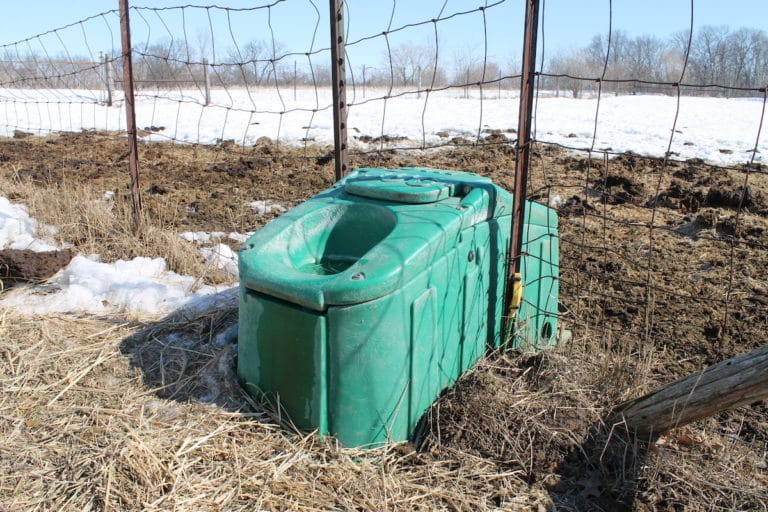Urban Homesteading | 25 Ways To Begin Today
Yes, we live on a small farm now. But our roots are actually in urban homesteading! Homesteading is not defined by your land or location! Urban, suburban, or rural – you can live a homesteading lifestyle wherever you’re at. Here are our 25 ways to begin a homestead lifestyle today!
Our Urban Homesteading Roots
For 5 years we lived in an adorable cape cod nestled on 1/3 acre in the suburbs. It was bare bones, but it proved to be the perfect spot to get connected in the local food and farming community and learn the ropes of homesteading.
Each year we tackled a new urban homesteading adventure.
First was backyard chickens. Then we expanded our gardening. Next, we ventured into beekeeping. Then we planted 8 fruit trees and other fruit bearing bushes. And our final hoorah was to move the gardening up front and turn our whole front lawn into a garden!
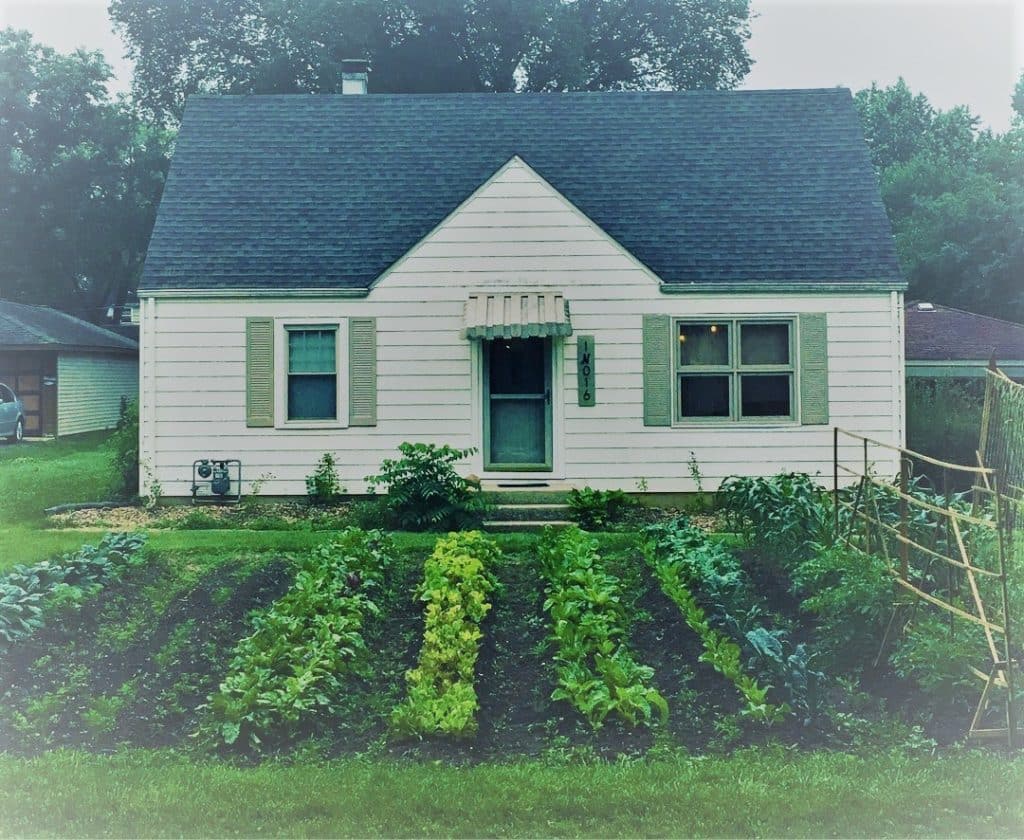
So many other skills followed suit. In the kitchen, we tried canning and other food preservation techniques. Then came fermentation and things like cooking a whole chicken.
Around the house, we tackled lots of DIY projects and figured out how to be resourceful with repurposed materials. We were able to redo our kitchen with nearly all used items and we even built a moveable chicken tractor out of an old wooden kid’s playset we came across for free.

We were doing it. We were homesteaders!
However, the doing had a progression to it. Some important steps preceded the doing. We’ll get to that.
But first…
What Is Urban Homesteading?
Urban homesteading is a beautiful thing because anyone, anywhere can be doing it. There is no list of things one must do to be labeled an urban, or even non-urban, homesteader.
We truly believe homesteading is more of a lifestyle, a mindset than anything. It involves a deep, intimate connection with one’s food from soil to plate. It’s the perfect marriage of simplicity and resourcefulness with a spirit to recapture skills of the past. And it’s a call to be a good steward of resources and adopt sustainable practices.
This requires two things: Self-sufficiency and community-sufficiency.
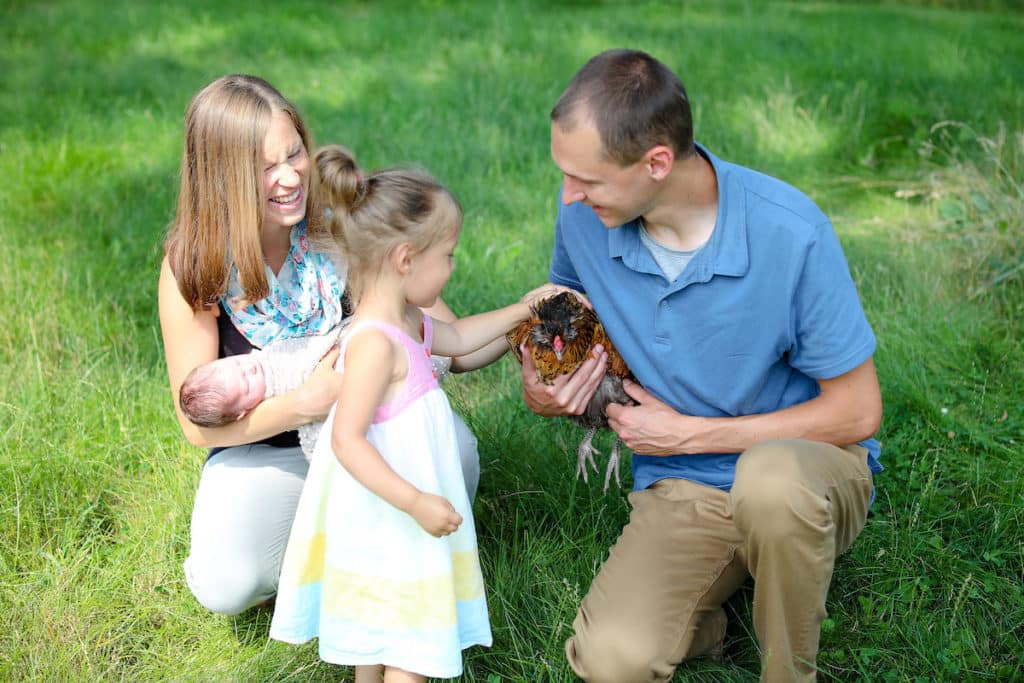
Self-Sufficiency
We as homesteaders feel a deep yearning to produce with our hands. To grow food and nourish our families. To not always settle for the storebought option but learn how to make it ourselves. To be less dependent on the systems in place around us. And to be more in tune with and dependent on the natural world. That’s self-sufficiency.
Community Sufficiency
Urban homesteading also means you can’t possibly do it all on your own. Land and resources are limited. You’ll need to simultaneously pour into and lean on the community that surrounds you. Finding other growers and producers who have what you don’t and purchasing or bartering for their products.
3 Steps to Urban Homesteading
If you’re like us and starting completely from scratch in your urban homesteading journey, just getting going can seem so so intimidating. But with taking small, achievable steps along the way, you can cover a lot of ground quickly. Here’s a breakdown of the steps we took that both allowed us to homestead in a suburban setting and also helped make our transition to 5 acres go so much smoother.
Step 1: Get Connected
Find like-minded people, groups, and organizations with shared values and goals. Believe me, we get it that trying to homestead in an urban setting can feel isolating. You’re always “those people” going against the grain and doing weird things like making kombucha and sewing your own clothes.
One of the most helpful ways we made connections was by visiting local farms and farmers and farmers markets. Seriously, on every farm that looked even remotely interesting locally, we’d try and visit to ask questions, observe what they’re doing, and usually come home with something awesome and delicious.
And trips to area farmers markets were just a regular part of our summertime weekend routine. We loved getting to know particular vendors, learning about the seasonality of food, and finding new and exciting fresh, locally grown foods to experiment with in the kitchen.

There can also be many groups or non-profits to explore where you can meet other urban homesteaders. We volunteered a bit with a local gardening non-profit that built raised bed gardens for food insecure families. We also attended some of their gardening workshops.
These connections are vital to meeting the right people, growing your community, and learning about what all the homesteading life entails.
Step 2: Learn Skills
After the first step of visiting, exploring, and getting connected, it only makes sense to begin learning the skills that most interest you.
Some skills like canning we were able to teach ourselves through books or online resources. Other skills, like beekeeping, we actually took a class for locally. This gave us the hands-on experience and confidence we needed to start beekeeping in our suburban backyard. It also gave us somewhat of a mentor to reach out to when questions came up since our instructor was a local beekeeper.
We even took a farm beginnings course that was hosted through a local non-profit farmer training program. While we ultimately decided that we more interested in homesteading than farming, it gave us such a great window into the business side of farming, taught us valuable skills, and connected us with so many local food producers in our area.

Another huge learning opportunity for us was that instead of just joining a CSA (Community Supported Agriculture) with a local farmer, we looked for work shares. Work shares are where you trade a few hours of labor each week on the farm in exchange for a CSA box. We volunteered weekly at a vegetable CSA and learned transplanting, weeding, harvesting, irrigation methods, and how to wash, pack, and store fresh produce.
These were the types of opportunities that gave us the confidence to go after things on our own land. Yes, some things you’ll just need to dive into head first and learn as you go. But if you’re able to seek out a mentor or teacher that can show you the basics and help you troubleshoot as you go, you’ll be so much better off!
Step 3: Start Doing!
We have this step intentionally last for a reason. From our experience, the doing part of urban homesteading goes smoothest when you’ve made the right connections to learn from along the way and picked up the skills and education you need to do things well.
Taking on too much or something you’re not prepared for can leave you discouraged or burnt out.
Below is a list of ways you can start doing on your homestead. It’s not exhaustive and you shouldn’t try to do all of them. But our hope is that it inspires you to see the possibilities to start urban homesteading right where you are at!
Our Top 25 Ways to Pursue an Urban Homesteading Lifestyle Today Regardless of Location
1. Grow vegetables
Vegetables are such a fun place to start and perfect for urban homesteading because you can grow a lot in small spaces! Our biggest tip when it comes to growing vegetables is grow what you like and will eat! There’s nothing like a garden fresh tomato and it’s so easy to preserve the easy growing kale to last you all winter long!
Whether you do raised beds, containers, or directly into the ground, figure what will work best for your space and get started!

2. Plant a three sisters garden
Three sisters gardening – corn, beans, and squash – is an incredible method of growing storage crops. This traditional companion planting method starts with mounds of corn, then beans trellis up the corn stalks, and squash grows between each mound acting as ground cover.
Yes, the squash can be sprawling and require some space. But it can also be done in small scales and still produce prolific amounts of food. Growing the three sisters has played a big role in being able to feed our family year-round off our homestead.


3. Grow potatoes
We love potatoes! They require very little attention after planting, make for a fun filled family treasure hunt to dig up in the fall, and store amazingly well to enjoy all through the winter.
Potatoes typically produce 8 times what you plant. This is incredible value! So, for every pound you plant you can expect around 8 lbs. produced. And if you don’t have land, you can easily plant them in containers or grow bags!
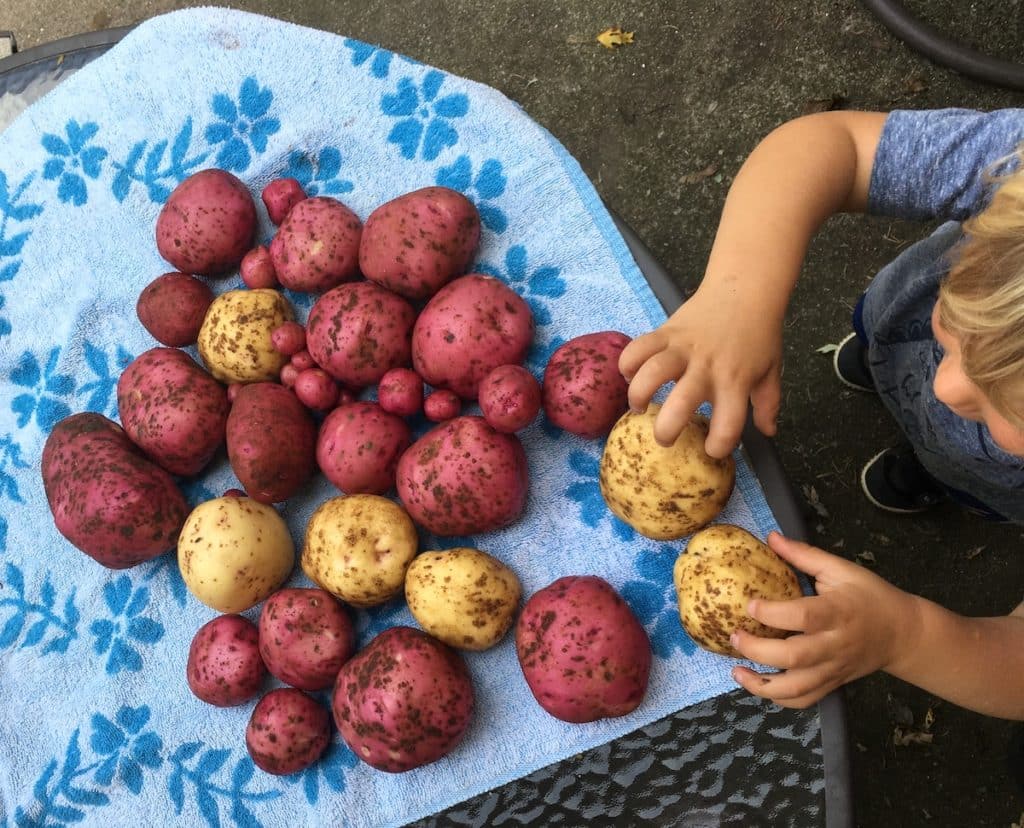
4. Reduce EMF’s
Not everything with homesteading revolves around food! There are many other ways to nourish your body and sometimes reducing environmental toxins can pay huge dividends. Frequent or concentrated exposure to EMF’s, or electromagnetic frequencies, have been tied to many negative health issues including poor sleep, foggy brain, fatigue, increased stress, and even greater risk of cancer.
You can find more ideas of ways to reduce EMF exposure in your life here. Ways that we have reduced EMFs in our home for years are turning off our wi-fi and cell phones at night, unplugging electronics when not in use, using an EMF proof cellphone case, or using our cell phone on speakerphone whenever possible.
5. From scratch cooking
Learning to cook from scratch can be so empowering! Less dependency on the grocery store, being able to make foods with better and fewer ingredients, and it tastes great.
We understand that from scratch cooking can be intimidating to start. But overtime, you’ll be making things that you never knew were possible. Looking for a place to start? Check out our post How to Slow Cook a Whole Chicken in the Oven. Learning to cook a whole chicken will save you money, give you meals worth of meat, and leave you with nutrient rich bone broth!

6. Canning & preserving
A great way to put away the abundance of what you grow or be able to eat the bounty of what you purchase from a local farm or farmer’s market year-round is to can or preserve it. Canning is actually a super simple process. I was able to teach myself simply by reading the instructions on the pressure canner we purchased.
Freezing and dehydrating are great ways to preserve the harvest as well! In fact, we only can a few things but most of the produce we preserve is done by freezing or preserving!
7. Make sourdough
After a period of eating grain free in our health journey, sourdough was one of the first things we wanted to try after reintroducing grains. I have fond memories of the first sourdough starter we created from spores collected out the back window of our suburban cape cod. We still use it today! The fermentation process sourdough bread goes through makes the gluten and nutrients within sourdough more digestible. Overall, it’s just healthier than highly processed storebought bread options!

There are SO many yummy creations when it comes to sourdough. Some of our favorites are our sourdough deep dish pizza, sourdough pancakes, and sourdough scones! And if you’re not into having to constantly feed and use your sourdough starter, like us, we share our once-a-month batch sourdough routine where we keep the starter in the fridge and reactivate it as needed.
8. Mill your own flours
Ground flours go rancid quickly and the industrial milling process most storebought options go through remove nearly all the nutrients. But grains in their whole form, like the wheat berries that are ground into flour, have a long shelf life and can maintain their nutritional value when properly stored for years.
We bought a hand grain mill years ago and have been sourcing our grains from a local organic mill. The freshness and taste of hand milled grains can’t be beat! Our post, How To Make Flour – Using a Hand Grain Mill at Home, takes you through different grain mill options and the many benefits of milling your own flour at home.

9. Beekeeping
Keeping bees is such a versatile activity. Obviously, harvesting honey from the hive comes to mind. But you can also get beeswax for things like home skin care and candle making, propolis which is an extremely effective immune booster, and you’ll simultaneously be pollinating your gardens along with your neighbors’.
Beekeeping can be done on a rooftop in an urban setting just as easily as it can be done in a backyard. You’ll want to check your local ordinances, but many areas are friendly and encouraging toward beekeepers. We kept one hive in the backyard of our suburban home. Not only are bees docile and safe to keep around, but the innerworkings of the hive are remarkable to observe!

10. Composting
It boggles my mind that some towns and HOA’s don’t allow composting! To me, it should be illegal NOT to compost! Composting is collecting food scraps, leaves, grass, and other yard clippings in a heap. This pile heats up breaking down the compost materials over time and turning them back into organic matter, or compost.
You can go the route of buying a compost tumbler that keeps your compost contained and makes turning it over easy. Or, you can build a really basic container system in your yard. We built 2 large compost bins out of pallets that can fit all of our food scraps and yard waste for the year. Then, after routinely turning the piles over, you have nutrient rich compost to add to your garden the next year!

11. Backyard laying hens
One of our first entry points into urban homesteading was backyard chickens. How cool is it that you can have a constant supply of protein rich eggs right in your backyard! We started with 6 layers in a prefabricated kit coop that we received as a gift. Then we eventually built a moveable chicken tractor that housed 8 more chickens bringing our total to 14.
Several chickens can provide more than enough eggs for your family. And we find having them around to be both entertaining and therapeutic! Again, you’ll want to check what’s allowable in your area. But there are strong pushes in many areas to begin allowing backyard chickens. If towns are really serious about increasing their sustainability, allowing and encouraging backyard chickens is the first step I’d take!
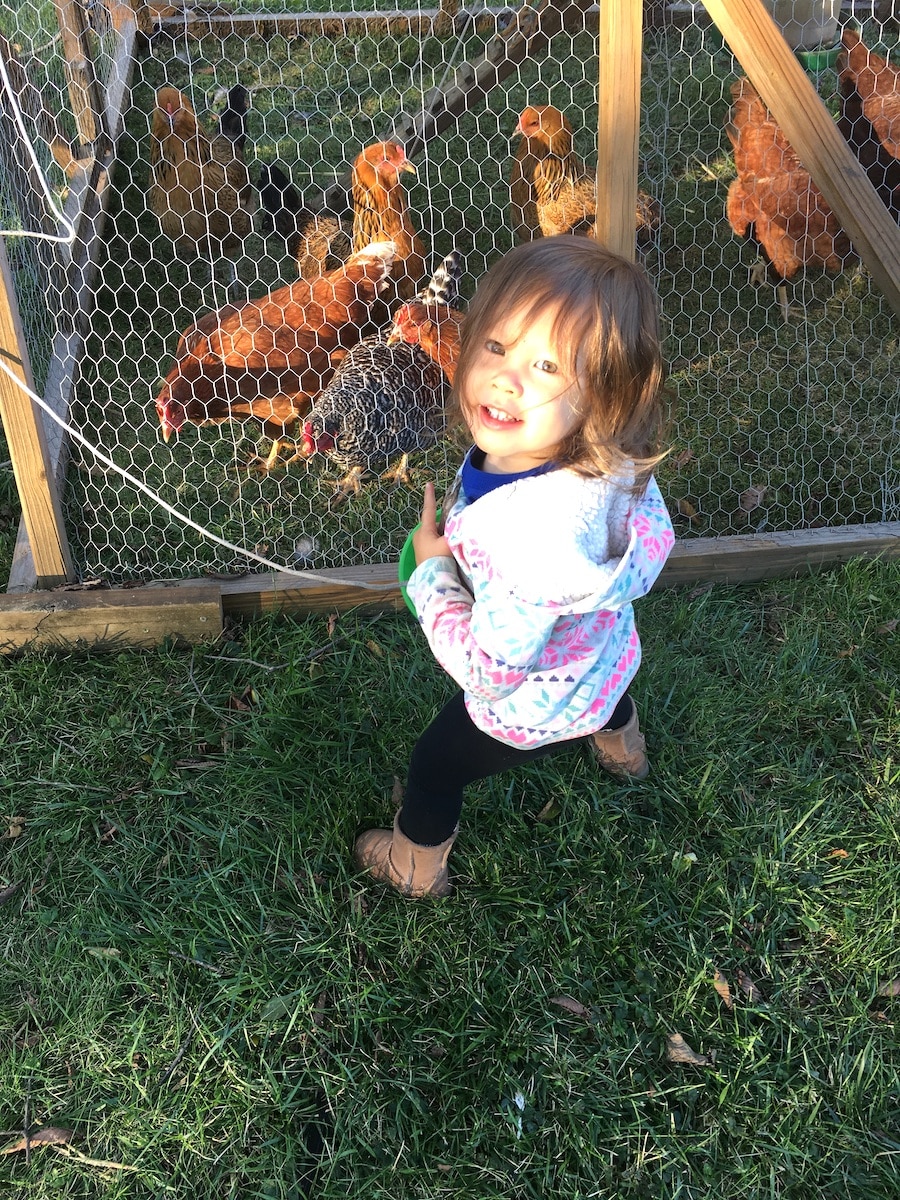

12. Milking Goats or Sheep
Hey, you never know! This may be a stretch, but don’t discount what’s possible until you explore it. We have friends in Chicago that have a small herd of milking goats that they rotate from vacant lot to vacant lot for grazing. Through this they provide goat milk to many families in a very urban setting. Even when we lived in the suburbs, someone in our neighborhood had sheep and they passed them off as therapy sheep!
Small ruminants that can be milked, like sheep or goats, can provide prolific amounts of food and nutrition. Butter, cheese, yogurt, kefir, ice cream!… all things you’d have access to making with a dairy animal.
13. Foraging
Growing food in a garden is great. But what if there was an option to just go out and harvest super nutrient dense foods with no work and weeding attached to it? Hence foraging! Getting started in foraging can make your head spin. There are so many different plants to learn to identify. But we’ve found it most helpful to learn one plant at a time to not get overwhelmed.
Nettle was one of the first plants we foraged for. Our post, How to Preserve Nettle, explains our nettle harvesting and eating process. This tasty and nutritious green can be cooked and eaten fresh or dried and preserved for later. Dandelion, wild mint, and elderberries are also common edible plants you can forage for. Check out our recipes for Gluten Free Dandelion Cake, Fresh Mint Brownies, and Elderberry Gummies for a sweet treat the whole family will love!
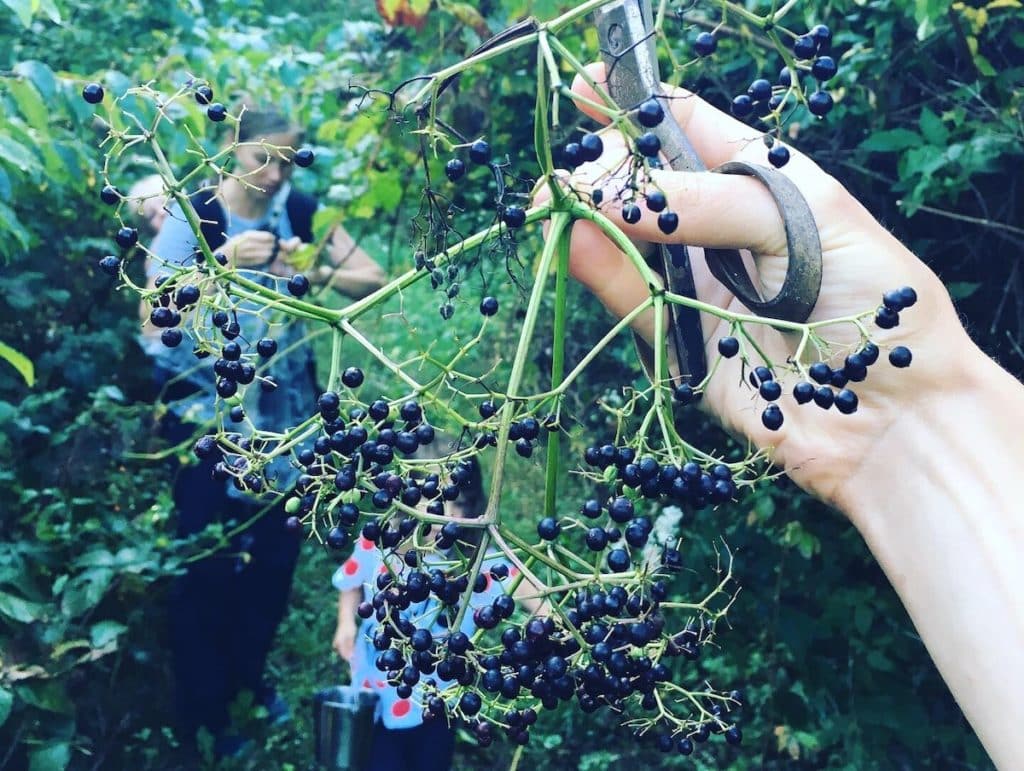
14. Grow Mushrooms
That magical world of mycelium under our feet is fascinating. And mushrooms can have so many health benefits! There are lots of ways to start growing mushrooms in small spaces.
Mushroom logs are most common. We recently inoculated logs with plugs, or little wooden dowels that contain mushroom spores. It was a fun project the whole family can participate in, the logs take up hardly any space, and we look forward to harvesting our own mushrooms. There are also ways to inoculate mulch piles with mushroom spores or even home grow kits that can sit right in your kitchen!

15. Raise chickens/poultry/other animals for meat
Believe me, if we suburban raised kids can butcher our own chickens, so can you! We actually walk you through all you need to know in our post Beginners Guide to Processing Chickens at Home. But there are so many other options besides chickens: turkeys, geese, rabbits, quail.
Some friends of ours living in a normal suburban neighborhood recently raised a batch of quails that they raised for meat and butchered. And rabbits are becoming hugely popular in homesteading circles. You can raise them without much space, they reproduce prolifically, and they taste great!

16. Fruit trees/bushes
If you’re going to plant a tree, why not make it a productive one?! Maybe you can put some blueberry bushes in your landscaping instead of that boxwood. Or form a hedge with some raspberry shoots. When it comes to fruit trees and bushes the possibilities are endless, and they don’t need to take up much space.
We planted 8 fruit trees on our 1/3 acre. Plus, there were already several mature and producing mulberry trees lining the back and side of the property that we (and our chickens!) loved getting fresh berries from. Some smaller fruit trees or shrubs can even be potted when land is not available. Our post, Beginners Guide to Homestead Fruit Trees, give tips on selecting and adding fruit trees to your property.

17. Support local farms
Urban homesteading and a strong and vibrant local food system go hand in hand. Small to mid-scale farmers have it tough; constantly at the mercy of weather, hard non-mechanized work, cheap grocery store competition, slim margins, and the ever-increasing cost and diminishing availability of farmland. Those called to cultivating the soil and growing or raising food deserve our full support.
We believe in the notion that you vote with your dollars. Without consistent support, local food farmers will lose out every time to cheap industrialized food. We’ve seen it with dear farmer friends who just couldn’t stay in business. Join a farm CSA (community supported agriculture). Pick up what you need each week at the farmers market. Visit farms and come home with a haul. Shop local!

18. Learn cheesemaking
It may not be practical in an urban setting to have a milk cow or other milking animal. We get that. But, one day you might just have one, as we came to find out! And even if you don’t, cheesemaking is such an amazing and fun process to learn!
When we lived in the suburbs, we started buying raw milk from a local dairy farm with a nearby pickup spot. It wasn’t long before we ventured into cheesemaking and discovered how easy and delicious it was to make our own Mozzarella! From there, we eventually tried a hard cheese and came up with this really simple Farmhouse Cheddar recipe.

19. Edible landscaping
Landscaping doesn’t need to be dull and nonproductive. Many food producing plants offer beauty and vibrancy along with the ability to harvest and be added to a meal.
Plant some asparagus that will pop up delicious shoots year after year. Kale and swiss chard can bring a blast of color and texture to any space. Garlic or chives can be used similar to an ornamental grass. And culinary and medicinal herbs can fit any landscaping, whether potted or in ground.

20. Collect rainwater
With more and more urban land being developed or paved, so much rainwater just runs off to the local storm sewer. But retaining that water helps you not rely entirely on municipal water supplies and instead utilize the abundant resources nature gives you.
Connecting rain barrels to downspouts is a common way to do this. These 50+ gallon drums can hold a lot of water that you can have on hand to keep your gardens lush and green in dry times. There are also more elaborate rainwater collection systems that utilize larger storage tanks.
21. DIY skin care
Did you know your skin is your body’s largest organ? It’s true! And so many commercial skin care products are chemically based causing your body to constantly absorb toxins. Try nourishing your body instead with homemade skin care products using ingredients you can actually pronounce!
And it’s really not that hard! We have found that tallow-based skin care products are our favorite because of how nourishing it is for our skin and we can source grass fed suet locally to render into tallow. Some of our favorite DIY skin care products are our tallow magnesium lotion, deodorant, and sunscreen.

22. Eat seasonally
The more you connect to your food and how it’s grown, the more seasonal eating just makes sense. Grocery stores solved some food problems, but they created a long list of others. Does it make sense to be eating tomatoes year-round when ¾ of the year they’re flown in from halfway around the world using incredible amounts of energy and resources? Or can we be ok eating fresh tomatoes from our garden during the summer months and then can tomato sauce or make sundried tomatoes that we can use the rest of the year?
We have found eating seasonally to not only be healthier, but to be so freeing. It has allowed us to cut ties with an industrial food system that tells us we should have the right to any food at any time of the year, whatever the cost. It takes a bit of planning, but moving toward seasonal rhythms to your food consumption can pay so many dividends. We share some tips of how we do this in our post, 7 Tips to Save Money on Organic Groceries.

23. Following circadian rhythms
Unfortunately, one of the downsides of our modern conveniences is that it has completely removed our dependence on natural circadian rhythms. With bright lights and screens on late into the night, why go to bed when it’s dark? When black out curtains cover the early morning’s suns first rays, why wake up with the sun?
These habits that were so natural for our ancestors are actually some of the most health promoting choices we can make. It may take some retraining and new habits, but we have found living in these natural patterns to make such a positive impact on our sleep and overall demeanor.
24. Shopping second hand
Being resourceful and homesteading are a match made in heaven! When we need something, the first place we look is the second-hand market. Now with resources like Facebook Marketplace, Craigslist, and a growing number of second-hand stores, it’s much easier to actually find some really great second-hand purchases. In fact, the vast majority of our favorite items in our home and wardrobe are items that we purchased second hand.
When we recently purchased our foreclosed 5-acre homestead, the whole house needed some updating. We set out looking for second hand items: kitchen cabinets, light fixtures, refrigerators, our AGA stove. We wound up with a space that had tons of character while paying a fraction of the cost if everything were new.

25. Eat Nose to Tail
When we lived in an urban setting, we always purchased a ¼ cow or a ½ pig from a local farm and made sure to get every single cut we could. This is a great way to not only support local farms but to eat every part of the animal, even rendering down the fat and finding a use for all of the organ meats (like these beef heart burgers).
Not only is eating nose to tail less wasteful, it also provides you with more nutrient dense foods. If you just stick with eating the popular muscle meats, you miss out on the most nutrient dense parts of the animals like the organs and collagen rich parts. In fact, incorporating regular organ meats into our diet had a huge impact on our health journey, which we share all about in our article on how liver changed my life. Eating nose to tail is also a great way to save money – buying an animal in bulk provides more bang for your buck!
Take Urban Homesteading In Stride!
Just remember – DON’T TRY IT ALL AT ONCE!
Follow the steps of connecting, learning, and then doing. Tackle one new project at a time. Once you feel comfortable with that and you have developed your systems, then start thinking about the next project around the corner.
Happy homesteading friends!
Get more homesteading inspiration:
- 14 Frugal Homestead Ideas
- Beginners Guide to Self Sufficient Homesteading
- Why a 5 Acre Homestead is the Perfect Size for a Beginner
- Homesteading Resources | Where To Begin In Your Homesteading Journey
Pin it for later!


